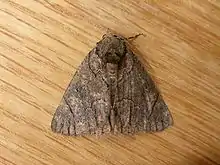Heliomystis
Heliomystis is a monotypic moth genus in the family Geometridae. Its only species, Heliomystis electrica, the electric moth, is found in the southern half of Australia[1] (New South Wales, Queensland, South Australia, Western Australia and Tasmania). Both the genus and species were first described by Edward Meyrick in 1888.[2]
| Heliomystis | |
|---|---|
 | |
| Scientific classification | |
| Kingdom: | Animalia |
| Phylum: | Arthropoda |
| Class: | Insecta |
| Order: | Lepidoptera |
| Family: | Geometridae |
| Genus: | Heliomystis Meyrick, 1888 |
| Species: | H. electrica |
| Binomial name | |
| Heliomystis electrica Meyrick, 1888 | |
The forewings are mottled shades of brown with black speckles and lines. These lines are usually stronger in females and diffuse whitish patches are present, particularly on the inner side of the postmedial line.
The larvae feed on Eucalyptus dives and Eucalyptus obliqua. They are green, often darker ventrally or sometimes dorsally, with a whitish spiracular line. The posture of the mature larvae is straight or slightly curved, with the thoracic legs held together and projecting from the body like a thorn from a stick.[3]
References
- Herbison-Evans, Don & Crossley, Stella (26 April 2014). "Heliomystis electrica Meyrick, 1888 Electric Moth". Australian Caterpillars and their Butterflies and Moths. Retrieved 16 April 2019.
- Savela, Markku. "Heliomystis Meyrick, 1888". Lepidoptera and Some Other Life Forms. Retrieved 16 April 2019.
- Pitkin, Linda M.; Han, Hongxiang; James, Shayleen (11 June 2007). "Moths of the tribe Pseudoterpnini (Geometridae: Geometrinae): a review of the genera" (PDF). Zoological Journal of the Linnean Society. 150 (2): 334–412. doi:10.1111/j.1096-3642.2007.00287.x. Archived from the original on 25 April 2012.CS1 maint: unfit URL (link)